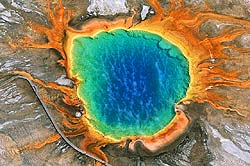The purpose of Discover EAPS:Life in Extreme Environments is to teach students basic earth science from the nature and causes of volcanic eruptions to the origin and diversity of microbial life in hot springs, to what we can tell about past climates from the fossil record. Participants in DEAPS fly from Boston to Bozeman Montana in the week before orientation. Upon arrival everyone s into rental vans and begins the trip, which will involve camping and touring in Yellowstone National Park and the surrounding region. We will leave Yellowstone at the end of the trip for a night in a motel in Bozeman and fly back to Boston the next day. For specific informaiton on this year's trip please see here.
 Yellowstone National
Park is roughly the
size
of the state of Connecticut.
Most of the park is located
in the northwestern corner
of Wyoming, but small
portions occur within
Montana and Idaho. The
park comprises
primarily high, forested,
volcanic
plateaus that have been
eroded over the
millennia by glaciation
and stream flow.
Yellowstone National
Park is roughly the
size
of the state of Connecticut.
Most of the park is located
in the northwestern corner
of Wyoming, but small
portions occur within
Montana and Idaho. The
park comprises
primarily high, forested,
volcanic
plateaus that have been
eroded over the
millennia by glaciation
and stream flow.
 With
half of the earthís
geothermal features,
Yellowstone holds the
planetís
most diverse collection
of geysers, hot springs,
mudpots, and
fumaroles. Its more than
300 geysers make up two
thirds of all those found
on earth. In all there
are more than 10,000
thermal features, including
hot springs,
bubbling mudpots, and
steaming fumaroles,
within the park.
With
half of the earthís
geothermal features,
Yellowstone holds the
planetís
most diverse collection
of geysers, hot springs,
mudpots, and
fumaroles. Its more than
300 geysers make up two
thirds of all those found
on earth. In all there
are more than 10,000
thermal features, including
hot springs,
bubbling mudpots, and
steaming fumaroles,
within the park.
The various geothermal
features owe their origin
to cataclysmic
volcanic eruptions over
the past 2 million years
which have left hot rock
and magma beneath the
area. To learn
about the overall geology of Yellowstone, try this United States Geological
Survey
web site.
 What Do We Do?
What Do We Do?
- Studying the volcanic history of the Yellowstone area
- Camp in Yellowstone Natl. Park
- Informal lectures by faculty and staff
- See geysers and hot springs
- Learn about life in extreme environments
- Detailed study of the chemistry and biology of hot springs
- See evidence of earthquakes and volcanoes
- See a fossil forest that is approximately 50 million years old

